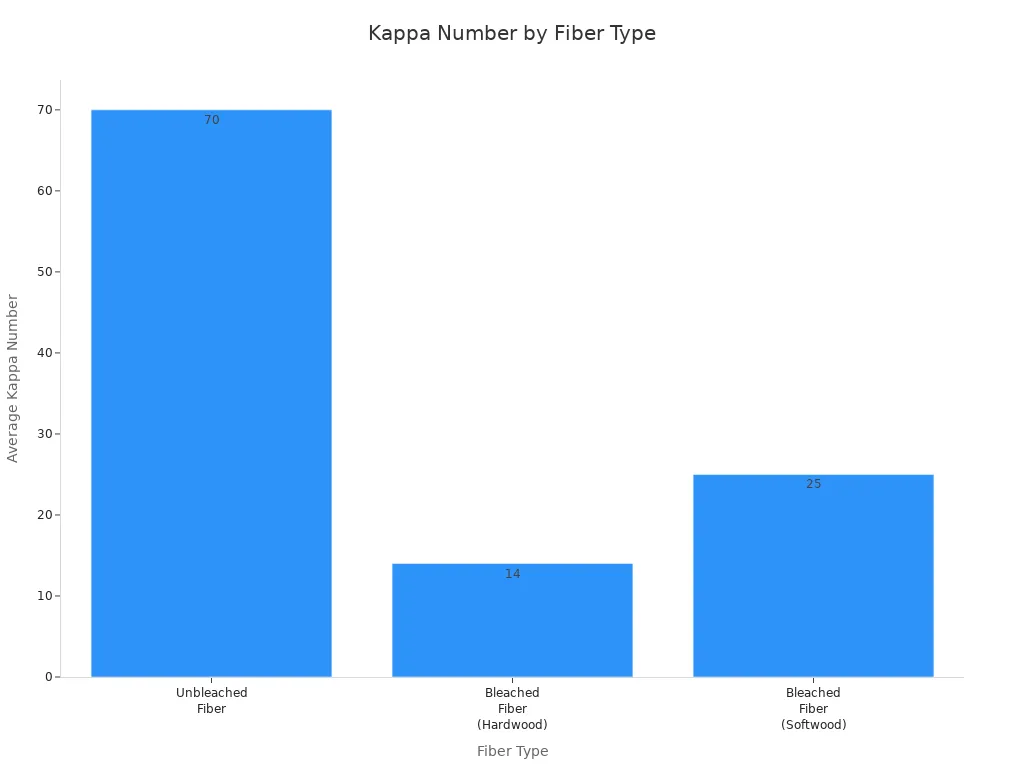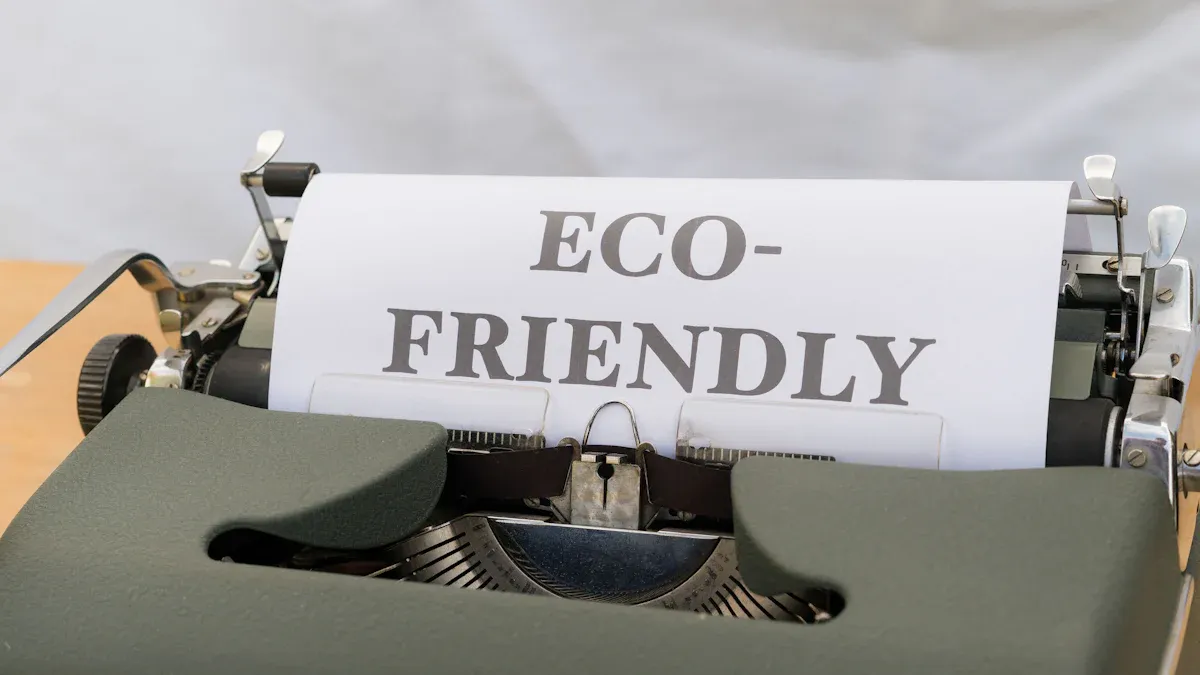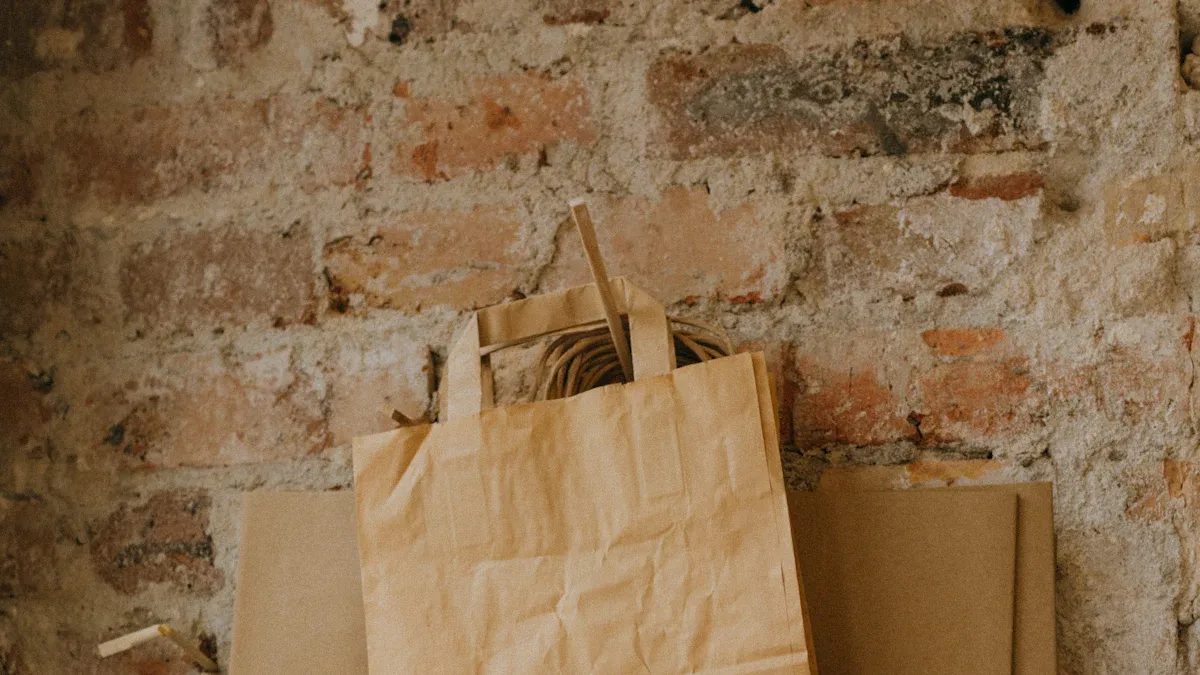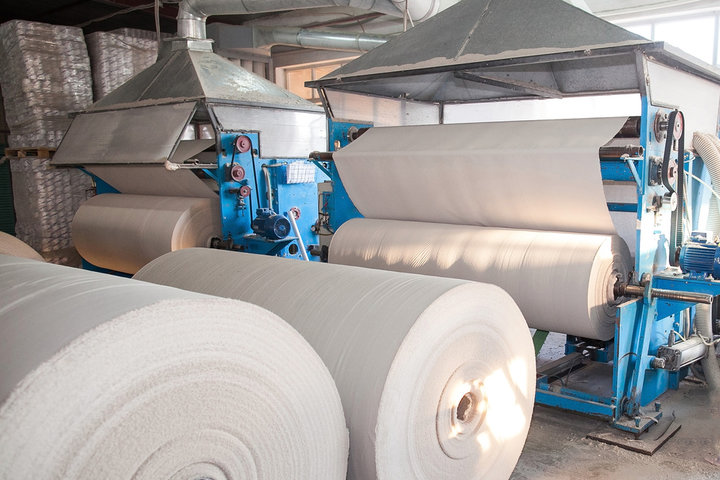
Unbleached fibre in paper helps the environment. You help the Earth when you pick paper with fewer chemicals. This paper also needs less processing. Many people want eco-friendly choices. Some people are not sure what makes paper good for nature.
Unbleached paper breaks down fast and is easy to recycle. Have you thought about how your paper choices change the environment?
Key Takeaways
Picking unbleached paper uses fewer chemicals and makes less pollution. This helps keep water and soil clean. Unbleached fibre paper is easier to recycle and compost. This means less trash goes to landfills. Using unbleached kraft paper helps with better packaging, hygiene, and farming. Try to find unbleached and natural labels when you buy paper. This helps you make choices that are good for the planet. Businesses can save money by using unbleached paper. They can also get more customers who care about the environment. This matches their green goals.
Unbleached Fibre Basics
What Is Unbleached Fibre
Unbleached fibre is found in lots of paper. It comes from wood pulp that is not bleached. The main types are mechanical wood pulp, sulphate wood pulp, and sulfite wood pulp. Each type is different and has special uses. Here is a table to show how they are not the same:
| Type of Pulp | Characteristics | Uses |
| Mechanical Wood Pulp | Cheap to make, soaks up ink well, not very strong, turns yellow easily | Newsprint, copy paper, printing paper, package paper, cardboard |
| Sulphate Wood Pulp | Strong, folds well, can be unbleached or bleached | Kraft paper, sack paper, kraft cardboard, common package paper and cardboard |
| Sulfite Wood Pulp | Long fibers, strong, comes in unbleached, semi-bleached, and bleached | Medium-quality printing paper, thin packaging paper, translucent paper, greaseproof paper |
You see unbleached fibre in kraft paper, newsprint, and packaging. These papers keep the wood’s natural color. They use fewer chemicals, so they are better for nature.
Unbleached vs. Bleached Paper
Unbleached paper is not the same as bleached paper. The big difference is how much lignin is left in the fibre. Lignin is a part of wood. Unbleached fibre keeps more lignin, so it has a higher Kappa number. Bleached fibre has less lignin and a lower Kappa number. This chart shows the difference:

Unbleached paper is brown because it keeps its natural color. Bleached paper is white since it goes through more steps to take out lignin. These steps use chemicals like chlorine and chlorine dioxide. These chemicals can cause problems:
Picking unbleached paper helps the planet. You avoid things that pollute water and hurt animals. Unbleached paper also breaks down fast and is easy to recycle.
Environmental Benefits

Reduced Chemicals and Pollution
When you pick unbleached fibre for paper, you help nature. Unbleached recycled fiber pulp uses fewer chemicals than bleached paper. Most unbleached papers do not use strong bleaching steps. This means less chlorine and fewer bad chemicals go into water. By choosing unbleached paper, you support green factories.
Here is a table that shows which chemicals are used less or not at all in making unbleached fibre paper:
| Chemicals Reduced/Eliminated | Description |
| Chlorine | Used less or skipped for safer choices |
| Chlorine Dioxide | Used as a safer bleaching chemical |
| Oxygen | Used as a safer bleaching choice |
| Ozone | Another safe option for bleaching |
| Hydrogen Peroxide | Used for bleaching without bad effects |
Unbleached recycled fiber pulp also makes less organochlorine pollution. These mills send out fewer harmful gases. TCF (Totally Chlorine Free) bleaching keeps chlorinated chemicals very low. ECF (Elemental Chlorine Free) bleaching lowers these chemicals but does not remove them all. Regular bleaching with elemental chlorine makes a lot of dioxins. These stay in nature for a long time.
When you choose unbleached paper, you help keep water and dirt clean. You also protect animals and plants from bad waste.
Energy and Water Savings
Unbleached fibre paper saves both energy and water when made. You help the Earth by picking papers made with unbleached recycled fiber pulp. Making unbleached paper skips many steps that need more heat and water. This helps lower the carbon footprint of paper factories.
Unbleached recycled fiber pulp needs less washing and rinsing. This means less water is wasted. You also help cut down greenhouse gas because the process uses less energy. Green ways of making paper make unbleached paper a smart pick for the planet.
You save resources by picking unbleached papers.
You help lower the need for fossil fuels.
You support cleaner air and water.
Recyclability and Compostability
Unbleached fibre paper can be recycled, breaks down, and can be composted. You help the world when you use unbleached recycled fiber pulp. These papers break down fast and turn into natural soil. You help close the loop in making paper and support green living.
Unbleached recycled fiber pulp keeps its natural look and strength. You see these fibers in kraft paper, packaging, and other green products. You can compost unbleached papers at home or in local programs. The natural wood fibers in unbleached paper are safe for nature.
Unbleached papers break down and can be composted.
You help cut down trash in landfills.
You support a cleaner and greener world.
Tip: Always look for unbleached recycled fiber pulp when you buy paper. Every choice helps the planet.
Unbleached Kraft Paper Applications

Unbleached kraft paper is used in many industries. It is strong and lasts a long time. People like it because it is good for the environment. You can find this paper in many places. Let’s see where unbleached kraft paper is used most.
Packaging and Shipping
Unbleached kraft paper is great for packaging. It helps keep things safe when you ship or store them. Here are some ways people use this paper every day:
Packaging boxes keep products safe during shipping.
Wrapping paper covers gifts and protects items.
Liner sheets add extra safety inside packages.
Void fill uses crumpled paper to stop things from moving.
This paper is stronger than bleached paper. It does not tear or break easily. The natural lignin in the paper makes it tough. That is why it is good for heavy packages. You can trust it to protect your things.
Tip: Pick unbleached kraft paper for packaging. It helps the Earth and cuts down on waste.
Hygiene and Tissue Products
Unbleached kraft paper is used in hygiene and tissue products. Many people like it because it uses natural fibers. It does not have harsh chemicals. Unbleached fibers, like cotton, make these products safe. Some brands use natural waxes to help with comfort and fluid control.
Unbleached kraft paper in hygiene products means less chemicals touch your skin.
These products feel soft and safe to use.
The natural look and feel make it good for sensitive uses.
Agriculture and Construction
Unbleached kraft paper is also used in farming and building. Farmers use it as mulch to protect crops. It keeps away birds, weeds, and bad weather. Advantage Kraft Mulch is made from kraft paper. It breaks down in the soil and adds good stuff to it. You can use it in greenhouses or outside fields.
Builders use unbleached kraft paper in construction. It helps shape concrete and supports building work. This paper is strong and easy to recycle.
Here is a table that shows how unbleached kraft paper helps the environment in farming and building:
| Benefit | Description |
| Biodegradability | Breaks down fast and can be composted, unlike plastic. |
| Reduction of Waste | Makes less trash in landfills and helps manage waste. |
| Recyclability | Can be recycled many times, saving resources. |
| Support for Circular Economy | Helps use resources better and cut down on waste. |
| Sustainable Sourcing | Comes from pine and spruce trees, made in a careful way. |
When you pick unbleached kraft paper, you help the planet. This paper supports recycling and makes less landfill waste. It is a smart choice for you and the environment.
Choosing Unbleached Fibre
Tips for Consumers
You can help the planet by picking unbleached fibre paper. Look for paper that is brown and not white. These papers use fewer chemicals and break down faster. When shopping, check for words like "unbleached" or "natural" on the package. You can also ask workers where the paper comes from. Many brands now tell you how they make their paper and what they do for the environment.
Tip: Choose paper that feels strong and looks brown. This usually means it is unbleached and better for the Earth.
If you want to do more, buy paper with recycled content. Recycled unbleached paper uses less water and energy. You can also compost many unbleached papers at home.
Business Considerations
Businesses can meet green goals by using unbleached fibre paper. You save money because you skip the bleaching step. This makes unbleached paper a smart pick for companies that care about the planet and costs. More customers want green products, so using unbleached paper helps your brand.
You can show you care about the Earth by using paper that is easy to recycle and compost. This cuts down on waste and helps the environment. Picking unbleached fibre supports a cleaner world for everyone.
Certifications and Labels
You can look for trusted labels to make sure your paper is green. These labels show the paper comes from good sources and meets high standards. Here is a table to help you know some common certifications:
| Certification Name | Description |
| Forest Stewardship Council (FSC) | Makes sure products come from forests managed in a good way, known for being green. |
| EcoLogo | A label for products that are better for the environment, used for paper. |
| Sustainable Forestry Initiative (SFI) | Focuses on good forest care, known for helping nature. |
| Programme for the Endorsement of Forest Certification (PEFC) | Supports good forest care with checks by other groups. |
| PCF | Shows recycled paper is whitened without chlorine, so it uses fewer chemicals. |
Look for these labels when you buy unbleached fibre paper. They help you make choices that are good for the planet and push more companies to go green.

Future of Unbleached Fibre
Industry Trends
Big changes are happening with unbleached paper. Many places want paper that is better for nature. North America uses new technology and lots of people buy this paper. Europe has strict rules and wants good, green paper. Asia-Pacific is growing fast because more cities and factories need paper. South America’s middle class is buying more, and stores are growing. The Middle East and Africa are building more and people have more money.
| Region | Characteristics |
| North America | Mature market with high adoption rates, technological advancements, and strong consumer spending. |
| Europe | Highly regulated environment with significant demand for sustainable and high-quality products. |
| Asia-Pacific | Fastest-growing region driven by rapid industrialization and urbanization. |
| South America | Emerging market with growing middle-class populations and expanding retail sectors. |
| Middle East and Africa | Significant potential due to infrastructure investments and rising disposable income. |
The market for unbleached paper keeps getting bigger. Packaging is the main reason for this growth. Factories are making more unbleached paper than before. In 2021, the world made more than ever. China needed 24% more unbleached paper for boxes. Experts think people will keep wanting more unbleached paper until at least 2026.
| Evidence Type | Details |
| Market Growth | The unbleached fibre paper market is projected to grow significantly due to increased demand in the packaging sector and regulatory shifts towards sustainable materials. |
| Production Increase | Global UKP production surged to a record high of 37Mt, with a 20% increase in sales of market pulp in 2021. |
| Demand Drivers | Chinese demand for UKP increased by 24%, driven by a fibre deficit in the containerboard sector. |
| Future Outlook | Strong import demand for UKP and URP is expected to continue through 2026 due to planned investments in containerboard capacity in China. |
Innovations
New ideas are changing how unbleached paper is made. Factories now use solar, wind, and biomass energy. This helps lower pollution. Nanotechnology puts tiny things in paper to make it stronger and easier to print. Low-concentration papermaking saves water and energy. AI and machine learning help fix problems and make better paper. IoT sensors watch how paper is made and help save resources. Robots and machines make paper mills safer and faster.
Solar, wind, and biomass energy power paper mills.
Nanotechnology makes paper stronger and better for printing.
Low-concentration papermaking saves water and energy.
AI and machine learning help make better paper.
IoT sensors watch and help use less.
Robots and machines make work safer and faster.
Scientists are also making unbleached paper even better for nature. They add things like nanofibrillated cellulose and chitosan to make paper stronger and safer for food. Unbleached bamboo pulp helps make paper that stops germs. New packaging can replace plastic and cut down on pollution. Wet strength improvements help paper last longer when wet. Biodegradable and non-toxic paper helps the world use less plastic.
| Evidence Description | Implications for Performance and Sustainability |
| Incorporation of sustainable additives like nanofibrillated cellulose and chitosan | Improves mechanical, barrier, and antimicrobial properties of unbleached fibre paper, addressing environmental concerns associated with traditional materials. |
| Development of antimicrobial paper from unbleached bamboo ASAM pulps | Enhances food safety and quality while promoting sustainability in packaging. |
| Creation of sustainable packaging materials | Urgent need to reduce environmental problems caused by petroleum-based polymers. |
| Enhancing paper packaging’s wet strength | Improves functionality while maintaining eco-friendliness. |
| Biodegradability and non-toxicity of paper | Supports the shift towards sustainable alternatives in the packaging industry. |
You help make the future better by picking unbleached paper. Every choice helps new ideas and a cleaner world.
You help the Earth when you pick unbleached fibre and kraft paper. These papers are good for many reasons.
| Trend | Impact |
| Market Growth | More companies use green paper for packaging. |
| Innovation | Stronger, lighter paper is used instead of plastic. |
You make the world greener when you choose sustainable paper. New ideas and more people wanting it will keep making unbleached fibre better for you and nature.
FAQ
What is unbleached fibre paper made from?
Unbleached fibre paper comes from wood pulp. The wood pulp keeps its natural color. Factories do not use strong bleaching steps. This paper uses fewer chemicals. It also keeps more of the wood’s strength.
Can you recycle unbleached fibre paper?
You can recycle unbleached fibre paper without trouble. It breaks down quickly and needs no extra steps. Many recycling centers will take it. Recycling this paper helps cut down waste. It also helps keep the environment clean.
Is unbleached fibre paper safe for food packaging?
Unbleached fibre paper is used for food packaging. It does not have harsh chemicals in it. Many brands use it for wrapping food and making containers. This helps keep food safe. It is also a green choice.
How does unbleached fibre paper help the economy?
Choosing unbleached fibre paper helps the economy. Factories save money by skipping the bleaching step. Businesses can meet green goals and get more customers. You also help support jobs in green industries.
Can you compost unbleached fibre paper at home?
You can compost unbleached fibre paper at home. It breaks down and turns into natural soil. This adds nutrients to your garden. It also helps cut down on landfill waste.




























